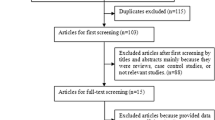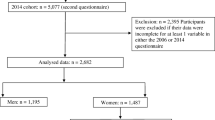Abstract
Summary
To elucidate the association of coffee and bone health would help fracture risk reduction via dietary intervention. Although those who had higher coffee consumption were less likely to have osteoporosis, the associations between coffee consumption and fracture risk need further investigations with better study designs.
Introduction
The associations between coffee consumption and the risk of osteoporosis and fracture remain inconclusive. We aimed to better quantify these associations by conducting meta-analyses of observational studies.
Methods
Relevant studies were systematically searched on PubMed, Web of Science, Cochrane library, and Embase Database up to November 25, 2021. The odds ratio (OR) or relative risk (RR) with 95% confidence intervals (CI) was pooled and a dose–response analysis was performed.
Results
Four studies with 7114 participants for osteoporosis and thirteen studies with 391,956 participants for fracture incidence were included in the meta-analyses. High versus low coffee consumption was associated with a lower risk of osteoporosis [pooled OR (95% CI): 0.79 (0.65–0.92)], while it was non-significantly associated with fracture incidence [pooled OR (95% CI): 0.86 (0.67–1.05) at hip and 0.89 (0.42–1.36) at non-hip]. A non-linear association between the level of coffee consumption and hip fracture incidence was shown (P = 0.004). The pooled RR (95% CI) of hip fracture risk in those who consumed 1, 2–3, 4, and ≥ 9 cups of coffee per day was 0.92 (0.87–0.97), 0.89 (0.83–0.95), 0.91 (0.85–0.98), and 1.10 (0.76–1.59), respectively. The significance in the association between coffee consumption and the hip fracture incidence decreased in those studies that had larger sample size, higher quality, and more adjustments.
Conclusions
A dose-dependent relationship may exist between coffee consumption and hip fracture incidence. The effect of high versus low coffee consumption was influenced by study designs. Further studies with dedicated designs are needed to confirm the independent effects of coffee consumption on bone health.



Similar content being viewed by others
Data availability
Data, code, and other materials that support the findings of this study are available from the corresponding author upon reasonable request.
References
Court-Brown CM, McQueen MM (2016) Global forum: fractures in the elderly. J Bone Joint Surg Am 98:e36. https://doi.org/10.2106/JBJS.15.00793
Richard W. Keen B, PhD, MRCP (2003) Burden of osteoporosis and fractures
Lane NE (2006) Epidemiology, etiology, and diagnosis of osteoporosis. Am J Obstet Gynecol 194:S3-11. https://doi.org/10.1016/j.ajog.2005.08.047
Bliuc D, Nguyen ND, Nguyen TV, Eisman JA, Center JR (2013) Compound risk of high mortality following osteoporotic fracture and refracture in elderly women and men. J Bone Miner Res 28:2317–2324. https://doi.org/10.1002/jbmr.1968
Pike CT, Birnbaum HG, Schiller M, Swallow E, Burge RT, Edgell ET (2011) Prevalence and costs of osteoporotic patients with subsequent non-vertebral fractures in the US. Osteoporos Int 22:2611–2621. https://doi.org/10.1007/s00198-010-1494-9
Brennan-Olsen SL, Vogrin S, Leslie WD et al (2017) Fractures in indigenous compared to non-indigenous populations: a systematic review of rates and aetiology. Bone Rep 6:145–158. https://doi.org/10.1016/j.bonr.2017.04.003
Rizzoli R, Bianchi ML, Garabédian M, McKay HA, Moreno LA (2010) Maximizing bone mineral mass gain during growth for the prevention of fractures in the adolescents and the elderly. Bone 46:294–305. https://doi.org/10.1016/j.bone.2009.10.005
Tsuang Y, Sun J, Chen L, Sun S, Chen SJJoos, research (2006) Direct effects of caffeine on osteoblastic cells metabolism: the possible causal effect of caffeine on the formation of osteoporosis. 1:7 https://doi.org/10.1186/1749-799x-1-7
Lu P, Lai C, Chan WJIjoms (2008) Caffeine induces cell death via activation of apoptotic signal and inactivation of survival signal in human osteoblasts. 9:698-718https://doi.org/10.3390/ijms9050698
Zhou Y, Guan X, Zhu Z, Guo J, Huang Y, Hou W, Yu HJBjop (2010) Caffeine inhibits the viability and osteogenic differentiation of rat bone marrow-derived mesenchymal stromal cells. 161:1542-1552https://doi.org/10.1111/j.1476-5381.2010.00998.x
Choi EJ, Kim KH, Koh YJ, Lee JS, Lee DR, Park SM (2014) Coffee consumption and bone mineral density in Korean premenopausal women. Korean J Fam Med 35:11–18. https://doi.org/10.4082/kjfm.2014.35.1.11
Choi E, Choi KH, Park SM, Shin D, Joh HK, Cho E (2016) The benefit of bone health by drinking coffee among Korean postmenopausal women: a cross-sectional analysis of the Fourth & Fifth Korea National Health and Nutrition Examination Surveys. PLoS ONE 11:e0147762. https://doi.org/10.1371/journal.pone.0147762
Doepker C, Franke K, Myers E, Goldberger JJ, Lieberman HR, O’brien C, Peck J, Tenenbein M, Weaver C, Wikoff D (2018) Key findings and implications of a recent systematic review of the potential adverse effects of caffeine consumption in healthy adults, pregnant women, adolescents, and children. Nutrients 10:https://doi.org/10.3390/nu10101536
Wikoff D, Welsh BT, Henderson R et al (2017) Systematic review of the potential adverse effects of caffeine consumption in healthy adults, pregnant women, adolescents, and children. Food Chem Toxicol 109:585–648. https://doi.org/10.1016/j.fct.2017.04.002
Li S, Dai Z, Wu Q (2015) Effect of coffee intake on hip fracture: a meta-analysis of prospective cohort studies. Nutr J 14:38. https://doi.org/10.1186/s12937-015-0025-0
Lee DR, Lee J, Rota M, Lee J, Ahn HS, Park SM, Shin D (2014) Coffee consumption and risk of fractures: a systematic review and dose-response meta-analysis. Bone 63:20–28. https://doi.org/10.1016/j.bone.2014.02.007
Sheng J, Qu X, Zhang X et al (2014) Coffee, tea, and the risk of hip fracture: a meta-analysis. Osteoporos Int 25:141–150. https://doi.org/10.1007/s00198-013-2563-7
Liu H, Yao K, Zhang W, Zhou J, Wu T, He C (2012) Coffee consumption and risk of fractures: a meta-analysis. Arch Med Sci 8:777–783. https://doi.org/10.5114/aoms.2012.31612
Li XL, Xu JH (2013) Coffee consumption and hip fracture risk: a meta-analysis. J Nutr Sci 2:e23. https://doi.org/10.1017/jns.2013.13
Poole R, Kennedy OJ, Roderick P, Fallowfield JA, Hayes PC, Parkes J (2017) Coffee consumption and health: umbrella review of meta-analyses of multiple health outcomes. BMJ (Clin Res ed) 359:j5024. https://doi.org/10.1136/bmj.j5024
Zengin A, Pye SR, Cook MJ, Adams JE, Wu FC, O’Neill TW, Ward KA (2016) Ethnic differences in bone geometry between White, Black and South Asian men in the UK. Bone 91:180–185. https://doi.org/10.1016/j.bone.2016.07.018
Edwards K, Leyland KM, Sanchez-Santos MT, Arden CP, Spector TD, Nelson AE, Jordan JM, Nevitt M, Hunter DJ, Arden NK (2020) Differences between race and sex in measures of hip morphology: a population-based comparative study. Osteoarthr Cartil 28:189–200. https://doi.org/10.1016/j.joca.2019.10.014
Dede AD, Tournis S, Dontas I, Trovas G (2014) Type 2 diabetes mellitus and fracture risk. Metabolism 63:1480–1490. https://doi.org/10.1016/j.metabol.2014.09.002
Oei L, Zillikens MC, Dehghan A et al (2013) High bone mineral density and fracture risk in type 2 diabetes as skeletal complications of inadequate glucose control: the Rotterdam Study. Diabetes Care 36:1619–1628. https://doi.org/10.2337/dc12-1188
Page MJ, McKenzie JE, Bossuyt PM et al (2021) The PRISMA 2020 statement: an updated guideline for reporting systematic reviews. BMJ 372:n71. https://doi.org/10.1136/bmj.n71
Wells GA SB, Connell D, Peterson J, Welch V, Losos M et al. The Newcastle–Ottawa Scale (NOS) for assessing the quality of nonrandomized studies in meta-analyses. http://www.ohri.ca/programs/clinical_epidemiology/oxford.asp
Rostom A DC, Cranney A, et al. (2004) Agency for Healthcare Research and Quality. https://www.ncbi.nlm.nih.gov/books/NBK35156/
JulianPTHiggins SGT, Deeks JJ, Altman DG (2003) Measuring inconsistency in meta-analyses. BMJ 327:557–560
Matthias Egger GDS, Schneider M, Minder C (1997) Bias in meta-analysis detected by a simple, graphical test. BMJ 315:629–633. https://doi.org/10.1136/bmj.315.7109.629
Colin B. Begg MM (1994) Operating characteristics of a rank correlation test for publication b. Biometrics 1088-1101https://doi.org/10.2307/2533446
Hernandez-Avila M, Colditz GA, Stampfer MJ, Rosner B, Speizer FE, Willett WC (1991) Caffeine, moderate alcohol intake, and risk of fractures of the hip and forearm in middle-aged women. Am J Clin Nutr 54:157–163. https://doi.org/10.1093/ajcn/54.1.157
Meyer HE, Pedersen JI, Løken EB, Tverdal A (1997) Dietary factors and the incidence of hip fracture in middle-aged Norwegians: a prospective study. Am J Epidemiol 145:117–123. https://doi.org/10.1093/oxfordjournals.aje.a009082
Hansen SA, Folsom AR, Kushi LH, Sellers TA (2000) Association of fractures with caffeine and alcohol in postmenopausal women: the Iowa Women’s Health Study. Public Health Nutr 3:253–261. https://doi.org/10.1017/s136898000000029x
van Geel AC, Geusens PP, Nagtzaam IF, Schreurs CM, van der Voort DJ, Rinkens PE, Kester AD, Dinant GJ (2006) Timing and risk factors for clinical fractures among postmenopausal women: a 5-year prospective study. BMC Med 4:24. https://doi.org/10.1186/1741-7015-4-24
Trimpou P, Landin-Wilhelmsen K, Odén A, Rosengren A, Wilhelmsen L (2010) Male risk factors for hip fracture-a 30-year follow-up study in 7,495 men. Osteoporos Int 21:409–416. https://doi.org/10.1007/s00198-009-0961-7
Ma CC, Burchfiel CM, Grove J, Fekedulegn D, Lu Y, Andrew ME, Willcox B, Masaki KH, Curb JD, Rodriguez BL (2011) Risk factors for fractures among Japanese-American men: The Honolulu Heart Program and Honolulu-Asia Aging Study. Arch Osteoporos 6:197–207. https://doi.org/10.1007/s11657-011-0068-6
van Lenthe FJ, Avendano M, van Beeck EF, Mackenbach JP (2011) Childhood and adulthood socioeconomic position and the hospital-based incidence of hip fractures after 13 years of follow-up: the role of health behaviours. J Epidemiol Community Health 65:980–985. https://doi.org/10.1136/jech.2010.115782
Määttä M, Terho E, Jokinen H, Pulkkinen P, Korpelainen J, Heikkinen J, Keinänen-Kiukaanniemi S, Jämsä T, Korpelainen R (2012) Lifestyle factors and site-specific risk of hip fracture in community dwelling older women–a 13-year prospective population-based cohort study. BMC Musculoskelet Disord 13:173. https://doi.org/10.1186/1471-2474-13-173
Hallström H, Wolk A, Glynn A, Michaëlsson K, Byberg L (2014) Coffee consumption and risk of fracture in the Cohort of Swedish Men (COSM). PLoS ONE 9:e97770. https://doi.org/10.1371/journal.pone.0097770
Dai Z, Jin A, Soh AZ, Ang LW, Yuan JM, Koh WP (2018) Coffee and tea drinking in relation to risk of hip fracture in the Singapore Chinese Health Study. Bone 112:51–57. https://doi.org/10.1016/j.bone.2018.04.010
Machado-Fragua MD, Struijk EA, Ballesteros JM, Ortolá R, Rodriguez-Artalejo F, Lopez-Garcia E (2019) Habitual coffee consumption and risk of falls in 2 European cohorts of older adults. Am J Clin Nutr 109:1431–1438. https://doi.org/10.1093/ajcn/nqy369
Hallström H, Wolk A, Glynn A, Michaëlsson K (2006) Coffee, tea and caffeine consumption in relation to osteoporotic fracture risk in a cohort of Swedish women. Osteoporos Int 17:1055–1064. https://doi.org/10.1007/s00198-006-0109-y
Hallström H, Byberg L, Glynn A, Lemming EW, Wolk A, Michaëlsson K (2013) Long-term coffee consumption in relation to fracture risk and bone mineral density in women. Am J Epidemiol 178:898–909. https://doi.org/10.1093/aje/kwt062
El Maghraoui A, Ghazi M, Gassim S, Ghozlani I, Mounach A, Rezqi A, Dehhaoui M (2010) Risk factors of osteoporosis in healthy Moroccan men. BMC Musculoskelet Disord 11:148. https://doi.org/10.1186/1471-2474-11-148
Wang Y, Ding H, Wang X, Wei Z, Feng S (2019) Associated factors for osteoporosis and fracture in Chinese elderly. Med Sci Monit: Int Med J Exp Clin Res 25:5580–5588. https://doi.org/10.12659/msm.914182
Acknowledgements
The authors wish to thank all participants dedicated to contributing to the study. This work is supported by the National Natural Science Foundation of China [No. 82003541], the Natural Science Foundation of Hunan Province of China [No. 2021JJ40371], and the Research Foundation of Education Bureau of Hunan Province [No. 20B367].
Author information
Authors and Affiliations
Corresponding authors
Ethics declarations
Ethics approval
All the authors confirmed that this work complied with ethical standards.
Conflict of interest
The authors declare no competing interests.
Additional information
Publisher's note
Springer Nature remains neutral with regard to jurisdictional claims in published maps and institutional affiliations.
Supplementary Information
Below is the link to the electronic supplementary material.
Rights and permissions
About this article
Cite this article
Zeng, X., Su, Y., Tan, A. et al. The association of coffee consumption with the risk of osteoporosis and fractures: a systematic review and meta-analysis. Osteoporos Int 33, 1871–1893 (2022). https://doi.org/10.1007/s00198-022-06399-7
Received:
Accepted:
Published:
Issue Date:
DOI: https://doi.org/10.1007/s00198-022-06399-7




